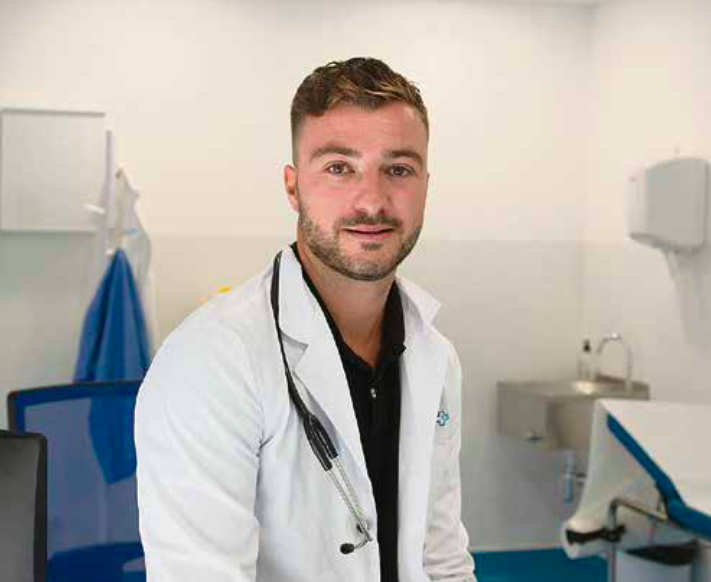

DUROGEZIK

Ask a doctor about a prescription for DUROGEZIK

How to use DUROGEZIK
INSTRUCTIONS FOR MEDICAL USE OF THE MEDICINAL PRODUCT MOTORIX (MOTORIX)
Composition
active substance: domperidone; 1 tablet contains 10 mg of domperidone; excipients: lactose, monohydrate; pre-gelatinized starch; sodium croscarmellose; microcrystalline cellulose; sodium lauryl sulfate; povidone; magnesium stearate; coating: Opadry II White film coating mixture (hypromellose (hydroxypropylmethyl-cellulose); lactose, monohydrate; polyethylene glycol; titanium dioxide (E 171); triacetin).
Pharmaceutical Form
Tablets, film-coated.
Main Physico-Chemical Properties
White, biconvex, film-coated tablets with a score line.
Pharmacotherapeutic Group
Drugs used for functional disorders of the gastrointestinal tract. Gastrointestinal motility stimulants. ATC code A03F A03.
Pharmacological Properties
Pharmacodynamics
Domperidone is a dopamine antagonist with antiemetic properties. Domperidone has a very low penetration across the blood-brain barrier. The use of domperidone is very rarely associated with extrapyramidal side effects, especially in adults, but domperidone stimulates the release of prolactin from the pituitary gland. Its antiemetic effect is probably due to a combination of peripheral (gastrokinetic) action and antagonism of dopamine receptors in the chemoreceptor trigger zone, which is located outside the blood-brain barrier in the posterior region (area postrema). Low concentrations of domperidone found in the brain indicate a predominantly peripheral action of the drug on dopamine receptors.
When taken orally, domperidone increases the pressure in the lower esophagus, improves antral-duodenal motility, and accelerates gastric emptying. Domperidone does not affect gastric secretion.
Effect on QT/QTc Interval and Cardiac Electrophysiology
According to international recommendations ICH-E14, a thorough study of the QT interval was conducted in healthy individuals. This study was a double-blind, placebo-controlled study using recommended and above-therapeutic doses (10 and 20 mg, 4 times a day). When taking 20 mg of domperidone 4 times a day, a prolongation of the QT interval was observed, and changes ranged from 3.4 to 5.9 ms throughout the observation period, and this indicator did not exceed 10 ms. The QT prolongation observed in this study when domperidone was administered according to the recommended dosage regimen is not clinically significant.
This lack of clinical significance is confirmed by pharmacokinetic parameters and QTc interval data obtained in two earlier studies that included 5-day treatment with 20 mg and 40 mg of domperidone, 4 times a day. ECG recordings were made before the study, on the 5th day, 1 hour (approximately at tmax) after the morning dose, and after 3 days. In both studies, no difference was found between QTc after active treatment and placebo. Therefore, it was concluded that taking domperidone at a dose of 80 and 160 mg per day did not have a clinically significant effect on QTc in healthy volunteers.
Pharmacokinetics
Absorption
Domperidone is rapidly absorbed after oral administration on an empty stomach, with maximum plasma concentration reached approximately 60 minutes after administration. The values of Cmax and AUC of domperidone increased proportionally with the dose in the dose range of 10 to 20 mg. A 2-3-fold accumulation of domperidone (AUC) was observed when administered 4 times a day (every 5 hours) for 4 days. The low absolute bioavailability of oral domperidone (approximately 15%) is due to extensive first-pass metabolism in the intestinal wall and liver. Although the bioavailability of domperidone increases when taken after food in healthy individuals, patients with gastrointestinal complaints should take domperidone 15-30 minutes before meals. Reduced gastric acidity decreases the absorption of domperidone. Bioavailability is reduced when taken simultaneously with cimetidine and sodium bicarbonate. When taken orally after meals, the maximum absorption is slightly delayed, and AUC is slightly increased.
Distribution
After oral administration, domperidone does not accumulate and does not induce its own metabolism; the maximum plasma level after 2 weeks of oral administration at 30 mg per day was almost the same as after the first dose (18 ng/ml). Domperidone is 91-93% bound to plasma proteins. Distribution studies of domperidone conducted in animals using a radiolabeled preparation showed significant distribution in tissues but low concentrations in the brain. In animals, small amounts of the preparation penetrate the placenta.
Metabolism
Domperidone is rapidly and extensively metabolized in the liver by hydroxylation and N-dealkylation. In vitro metabolism studies with diagnostic inhibitors have shown that CYP3A4 is the main form of cytochrome P450 involved in the N-dealkylation of domperidone, and CYP3A4, CYP1A2, and CYP2E1 are involved in the aromatic hydroxylation of domperidone.
Excretion
Excretion via urine and feces is 31% and 66% of the oral dose, respectively. The amount of the drug excreted unchanged is a small percentage (10% with feces and approximately 1% with urine). The half-life of domperidone from plasma is 7-9 hours in healthy volunteers but is prolonged in patients with severe renal impairment.
Special Patient Groups
Impaired Hepatic Function
In patients with moderate hepatic impairment (7-9 points on the Child-Pugh scale, class B according to the Child-Pugh classification), the AUC and Cmax of domperidone were 2.9 and 1.5 times higher, respectively, than in healthy volunteers. The free fraction increased by 25%, and the terminal half-life was prolonged from 15 to 23 hours. In patients with mild hepatic impairment, a slightly lower exposure was observed compared to healthy volunteers in terms of Cmax and AUC, without changes in protein binding and terminal half-life. The use of the drug in patients with severe hepatic impairment has not been studied. Motorix is contraindicated in patients with moderate or severe hepatic impairment (see "Contraindications").
Impaired Renal Function
In patients with severe renal impairment (creatinine clearance <30 ml/min/1.73 m2), the half-life of domperidone is prolonged from 7.4 to 20.8 hours, but the plasma concentration of the drug is lower than in patients with normal renal function. Since a very small amount of the drug (about 1%) is excreted unchanged by the kidneys, it is unlikely that dose adjustment will be required in patients with renal impairment. However, with repeated use, the frequency of administration should be reduced to 1-2 times a day, depending on the severity of the impairment, and the dose may need to be reduced.
Clinical Characteristics
Indications
For the relief of symptoms of nausea and vomiting.
Contraindications
Motorix is contraindicated:
- in patients with known hypersensitivity to the active substance or excipients of the medicinal product;
- in patients with prolactin-secreting pituitary tumors (prolactinoma);
- in patients with severe or moderate hepatic or renal impairment (see "Special Warnings and Precautions for Use" and "Pharmacological Properties");
- in patients with known prolongation of cardiac conduction intervals, particularly QTc, patients with significant electrolyte disturbances or with underlying heart conditions such as congestive heart failure (see "Special Warnings and Precautions for Use");
- in patients with liver failure;
- when stimulation of gastrointestinal motility may be harmful, such as in gastrointestinal hemorrhage, mechanical obstruction, or perforation;
- when used concomitantly with ketoconazole, erythromycin, or other potent CYP3A4 inhibitors;
- when used concomitantly with medications that prolong the QT interval (except apomorphine), such as fluconazole, erythromycin, itraconazole, oral ketoconazole, posaconazole, ritonavir, saquinavir, telaprevir, voriconazole, clarithromycin, amiodarone, telithromycin (see "Special Warnings and Precautions for Use" and "Interactions with Other Medicinal Products and Other Forms of Interaction").
Interactions with Other Medicinal Products and Other Forms of Interaction
Anticholinergic medicinal products may counteract the anti-dyspeptic effect of Motorix. Due to pharmacodynamic and/or pharmacokinetic interactions, the risk of QT interval prolongation is increased.
Antacids and antisecretory medicinal products should not be taken simultaneously with Motorix, as they reduce its bioavailability after oral administration (see "Special Warnings and Precautions for Use").
Domperidone is metabolized mainly by CYP3A4.
According to in vitro studies, concomitant use of medicinal products that significantly inhibit this enzyme may lead to increased levels of domperidone in the blood.
When domperidone is used concomitantly with potent CYP3A4 inhibitors that can prolong the QT interval, clinically significant changes in the QT interval have been observed. Therefore, concomitant use of domperidone with certain medicinal products is contraindicated (see "Contraindications").
Concomitant use with levodopa. Although dose adjustment of levodopa is not considered necessary, an increase in domperidone plasma concentration (up to 30-40%) has been observed when taken concomitantly with levodopa.
Concomitant use of the following medicinal products with domperidone is contraindicated.
- All medicinal products that prolong the QT interval (risk of "torsade de pointes"):
- antiarrhythmic medicinal products of class IA (e.g., disopyramide, quinidine, hydroquinidine);
- antiarrhythmic medicinal products of class III (e.g., amiodarone, dofetilide, dronedarone, ibutilide, sotalol);
- certain antipsychotic medicinal products (e.g., haloperidol, pimozide, sertindole);
- certain antidepressants (e.g., citalopram, escitalopram);
- certain antibiotics (e.g., levofloxacin, moxifloxacin, erythromycin, spiramycin);
- certain antifungal medicinal products (e.g., fluconazole, pentamidine);
- certain antimalarial medicinal products (e.g., halofantrine, lumefantrine);
- certain gastrointestinal medicinal products (e.g., cisapride, dolasetron, prucalopride);
- certain antihistamine medicinal products (e.g., mepyramine, mizolastine);
- certain medicinal products used in oncology (e.g., toremifene, vandetanib, vincamine);
- certain other medicinal products (e.g., bepridil, methadone, difemanil);
- apomorphine, except when the benefit of concomitant use outweighs the risks and under strict adherence to the precautions recommended for concomitant use (see apomorphine SmPC, section "Contraindications").
Examples of potent CYP3A4 inhibitors that are contraindicated with Motorix:
- azole antifungal medicinal products, such as fluconazole*, itraconazole, ketoconazole*, posaconazole, and voriconazole*;
- macrolide antibiotics, such as clarithromycin* and erythromycin*;
- protease inhibitors* (e.g., ritonavir, saquinavir, telaprevir);
- HIV protease inhibitors, such as amprenavir, atazanavir, fosamprenavir, indinavir, nelfinavir, ritonavir, and saquinavir;
- calcium channel blockers, such as diltiazem and verapamil;
- amiodarone*;
- aprepitant;
- nefazodone;
- telithromycin*.
*prolongs QTc interval.
Concomitant use of the following substances requires caution.
Cautious use is recommended with drugs that cause bradycardia and hypokalemia, as well as with the following macrolides that may cause QT interval prolongation: azithromycin and roxithromycin (clarithromycin is contraindicated as it is a potent CYP3A4 inhibitor).
Domperidone should be used with caution in combination with potent CYP3A4 inhibitors that do not cause QT interval prolongation, such as indinavir, and patients should be closely monitored for signs or symptoms of adverse reactions.
The above list is representative but not exhaustive.
Motorix can be combined with:
- antipsychotics, whose effect it enhances;
- dopamine agonists (bromocriptine, L-dopa), whose undesirable peripheral effects, such as gastrointestinal disorders, nausea, vomiting, it suppresses without neutralizing the main properties.
Special Warnings and Precautions for Use
Motorix is not recommended for motion sickness.
Motorix should be used with caution in elderly patients or patients with existing heart disease or a history of heart disease.
Cardiovascular effects. Domperidone has been associated with QT interval prolongation on the ECG. Rare cases of QT interval prolongation and ventricular arrhythmias have been reported during post-marketing surveillance in patients taking domperidone. These reports included information on patients with other risk factors, electrolyte disturbances, and concomitant therapy that may be contributing factors (see "Adverse Reactions").
In accordance with ICH-E14 recommendations, a thorough study of the QT interval was conducted in healthy individuals. The QT interval prolongation observed in this study when domperidone was administered according to the recommended dosage regimen is not clinically significant.
Precautions. Domperidone should be used with caution in patients with mild hepatic or renal impairment.
Motorix is contraindicated in patients with prolonged cardiac conduction intervals, particularly QTc, patients with significant electrolyte disturbances (hypokalemia, hyperkalemia, hypomagnesemia), or bradycardia, and patients with underlying heart conditions such as congestive heart failure (see "Contraindications"). Electrolyte disturbances (hypokalemia, hyperkalemia, hypomagnesemia) and bradycardia are conditions that increase the proarrhythmic risk.
In case of symptoms or signs that may be associated with cardiac arrhythmia, the use of Motorix should be discontinued, and the patient should consult a doctor immediately.
Patients should immediately report any symptoms related to the heart.
Motorix tablets contain lactose, so the medicinal product should not be used in patients with lactose intolerance, galactosemia, or glucose/galactose malabsorption.
Renal Impairment. The half-life of domperidone is prolonged in severe renal impairment. With repeated use, the frequency of Motorix administration should be reduced to once or twice a day, depending on the severity of the impairment; a dose reduction may also be necessary. Patients with severe renal impairment should be regularly monitored (see "Pharmacological Properties").
Hepatic Impairment. Motorix is contraindicated in patients with moderate or severe hepatic impairment (see "Contraindications"). Dose adjustment is not necessary in patients with mild hepatic impairment (see "Pharmacological Properties").
Pregnancy and Breastfeeding
Pregnancy
Data on the use of domperidone in pregnant women are limited. Therefore, Motorix should be used during pregnancy only when the expected benefit to the mother outweighs the potential risk to the fetus.
Breastfeeding
The amount of domperidone that may enter the body of a nursing infant through breast milk is extremely low. The maximum relative dose for infants (%) is estimated to be around 0.1% of the dose for the mother, adjusted for body weight. It is not known whether the drug is harmful to the infant, so mothers taking Motorix should avoid breastfeeding. The decision to stop breastfeeding or discontinue domperidone therapy should be made by assessing the benefit of breastfeeding to the child and the benefit of therapy to the mother. Caution should be exercised in the presence of risk factors for QTc interval prolongation in children who are breastfed. After exposure through breast milk, the occurrence of side effects, including cardiac effects, cannot be ruled out.
Ability to Affect Reaction Speed When Driving or Using Machinery
After taking domperidone, dizziness and drowsiness have been observed. Therefore, patients should be advised to avoid driving or operating machinery and other activities that require attention and coordination until it is known how the drug affects them.
Method of Administration and Dosage
Motorix should be used at the lowest effective dose for the shortest duration necessary to relieve symptoms of nausea and vomiting.
Adults and children over 12 years of age and weighing at least 35 kg: 1 tablet (10 mg) 3 times a day.
Maximum daily dose: 3 tablets (30 mg per day).
It is recommended to take Motorix before meals. Absorption of the medicinal product is slightly delayed when taken after meals. The patient should take the medicinal product according to the recommended dosage regimen. If a dose is missed, the next dose should be taken according to the recommended regimen. The dose should not be doubled to make up for the missed dose. The duration of treatment should not exceed 1 week.
Adults over 60 years of age. Before taking Motorix, patients over 60 years of age should consult a doctor.
Renal Impairment. Since the half-life of domperidone is prolonged in severe renal impairment, the frequency of Motorix administration should be reduced to once or twice a day, depending on the severity of the impairment; a dose reduction may also be necessary. Patients with severe renal impairment should be regularly monitored (see "Pharmacological Properties").
Hepatic Impairment. Motorix is contraindicated in patients with moderate or severe hepatic impairment (see "Contraindications"). Dose adjustment is not necessary in patients with mild hepatic impairment (see "Pharmacological Properties").
Children
Motorix should be used to treat children over 12 years of age and weighing at least 35 kg.
Domperidone should be prescribed to children at the lowest effective dose for the shortest duration.
Overdose
Symptoms: Overdose has been reported mainly in infants and children. Symptoms of overdose may include agitation, altered consciousness, seizures, disorientation, drowsiness, and extrapyramidal reactions.
Treatment. There is no specific antidote for domperidone, but in case of significant overdose, symptomatic treatment should be provided immediately. Gastric lavage within 1 hour after administration of the medicinal product, administration of activated charcoal, and close monitoring of the patient's condition and supportive therapy are recommended. ECG monitoring should be performed due to the possibility of QT interval prolongation. Anticholinergic medicinal products, anti-Parkinson's disease medicinal products may be effective in controlling extrapyramidal reactions.
Adverse Reactions
The safety of Motorix has been evaluated during clinical trials and post-marketing use. In double-blind, placebo-controlled clinical trials, 1275 patients with dyspepsia, gastroesophageal reflux disease, irritable bowel syndrome, nausea, vomiting, or other related conditions participated. All patients were at least 15 years old and received at least one dose of the medicinal product. The mean total daily dose was 30 mg (range 10-80 mg), and the median duration of exposure was 28 days (range 1-28 days). Patients with diabetic gastroparesis or symptoms caused by chemotherapy or parkinsonism were not included in the studies.
Assessment of the frequency of adverse reactions: very common (≥1/10); common (≥1/100 to <1/10); uncommon (≥1/1000 to <1/100); rare (≥1/10000 to <1/1000); very rare (<1/10000). If the frequency cannot be determined from clinical trial data, it is stated as unknown.
Under recommended dosage and duration of treatment, domperidone is generally well-tolerated, and adverse reactions occur infrequently.
Immune system disorders: frequency unknown - allergic reactions, including anaphylaxis, anaphylactic shock, hypersensitivity.
Endocrine system disorders: rare - increased prolactin levels.
Psychiatric disorders: uncommon - decreased or absent libido, irritability, excitement, nervousness; very rare - depression, anxiety.
Nervous system disorders: uncommon - headache, drowsiness, dizziness, extrapyramidal disorders; very rare - insomnia, thirst, lethargy, akathisia; frequency unknown - seizures, restless legs syndrome (worsening of restless legs syndrome in patients with Parkinson's disease).
Cardiovascular disorders: very rare - edema, palpitations, disturbances of heart rate and rhythm, serious ventricular arrhythmias; frequency unknown - QT interval prolongation, ventricular arrhythmias of the "torsade de pointes" type, sudden cardiac death.
Gastrointestinal disorders: common - dry mouth; uncommon - diarrhea; rare - gastrointestinal disorders, including abdominal pain, regurgitation, changes in appetite, nausea, vomiting, constipation; very rare - transient intestinal spasms.
Skin and subcutaneous tissue disorders: uncommon - rash, itching, urticaria; frequency unknown - angioedema.
Reproductive system and breast disorders: rare - breast enlargement, milk secretion, breast engorgement, changes in menstrual cycle; uncommon - galactorrhea, breast pain, breast tenderness; frequency unknown - gynecomastia, amenorrhea.
Musculoskeletal and connective tissue disorders: rare - leg pain.
Urinary system disorders: very rare - dysuria, frequent urination; frequency unknown - urinary retention.
General disorders: uncommon - asthenia.
Eyes: frequency unknown - oculogyric crises.
Other: conjunctivitis, stomatitis.
Changes in laboratory parameters: very rare - increased levels of ALT, AST, and cholesterol; frequency unknown - deviations from normal liver function tests, increased prolactin levels in blood.
In 45 studies where domperidone was used at higher doses, for longer periods, and for additional indications, including diabetic gastroparesis, the frequency of adverse reactions (except dry mouth) was significantly higher. This was particularly evident in pharmacologically predictable cases related to increased prolactin levels.
Since the pituitary gland is located outside the blood-brain barrier, domperidone may cause increased prolactin levels. In individual cases, such hyperprolactinemia may lead to neuroendocrine side effects, such as galactorrhea, gynecomastia, and amenorrhea.
During post-marketing use, no differences in the safety profile have been observed between adults and children, except for extrapyramidal disorders and other central nervous system effects, which were observed mainly in children.
Reporting of Suspected Adverse Reactions
Reporting of suspected adverse reactions after authorization of the medicinal product is important. It allows continued monitoring of the benefit/risk balance of the medicinal product. Healthcare professionals are asked to report any suspected adverse reactions via the national reporting system.
Shelf Life
3 years.
Storage Conditions
Store in the original packaging at a temperature not exceeding 25°C.
Keep out of the reach of children.
Packaging
10 tablets in a blister pack; 1 blister pack in a carton.
10 tablets in a blister pack; 3 blister packs in a carton.
Marketing Authorization Holder
Without a prescription.
Manufacturer
Kyiv Vitamin Plant, PJSC.
Manufacturer's Address
04073, Ukraine, Kyiv, Kopilivska Street, 38.
Web site: www.vitamin.com.ua.
- Country of registration
- Active substance
- Prescription requiredYes
- Manufacturer
- This information is for reference only and does not constitute medical advice. Always consult a licensed doctor before taking any medication. Oladoctor is not responsible for medical decisions based on this content.
- Alternatives to DUROGEZIKDosage form: patch, 25 mcg/hourActive substance: fentanylManufacturer: Янссен Фармацевтика НВPrescription requiredDosage form: patch, 50 mcg/hourActive substance: fentanylManufacturer: Янссен Фармацевтика НВPrescription requiredDosage form: patch, 75 mcg/hourActive substance: fentanylManufacturer: Янссен Фармацевтика НВPrescription required
Alternatives to DUROGEZIK in other countries
The best alternatives with the same active ingredient and therapeutic effect.
Alternative to DUROGEZIK in Испания
Alternative to DUROGEZIK in Польша
Online doctors for DUROGEZIK
Discuss dosage, side effects, interactions, contraindications, and prescription renewal for DUROGEZIK – subject to medical assessment and local rules.














